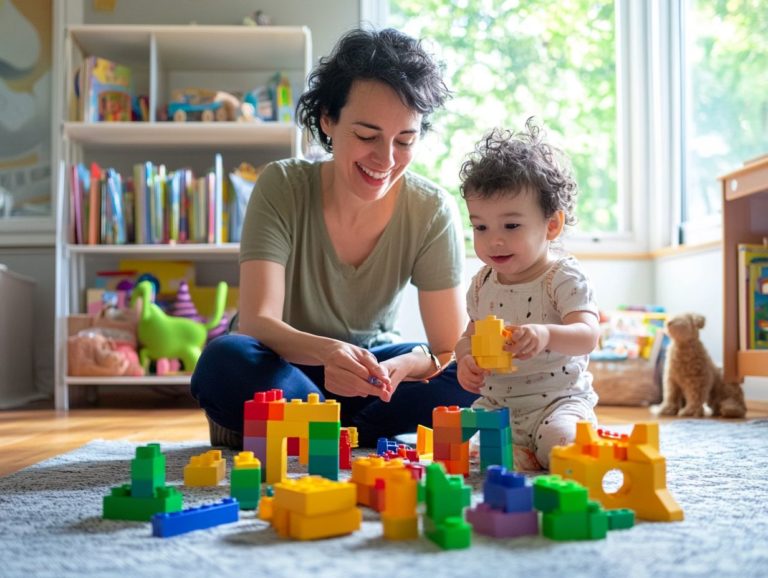The Impact of Tone on Parent-Child Interaction
Tone profoundly influences the dynamics of your interactions with your child, affecting everything from their emotional well-being to their behavioral development. The emotional tone you use can significantly impact early language development and the quality of parental speech.
Recognizing the distinction between tone and language itself is vital for cultivating effective communication. This article delves into the importance of tone in parent-child relationships, shedding light on the impacts of both positive and negative tones, and how socioeconomic status can influence these interactions.
You ll find strategies for enhancing communication, insights into the effects of harsh tones, and guidance on how to create a nurturing environment for your children, considering factors such as socioeconomic status and cultural heritage.
Discover the power of tone and its enduring effects on your family dynamics!
Contents
- Key Takeaways:
- What is Tone?
- The Role of Tone in Parent-Child Communication
- How Does Tone Affect a Child’s Development?
- How Does Tone Impact the Parent-Child Relationship?
- Positive vs. Negative Tone in Parent-Child Interaction
- What is Positive Tone?
- What is Negative Tone?
- How Can Parents Use Positive Tone to Improve Communication?
- Understanding the Effects of Harsh Tone on Children
- Strategies for Improving Tone in Parent-Child Interaction
- Active Listening
- Using ‘I’ Statements: Insights from Research
- Taking Breaks to Regulate Emotions
- Seeking Professional Help
- Frequently Asked Questions
- What is the impact of tone on parent-child interaction?
- How does a positive tone affect parent-child interaction?
- Does tone of voice play a role in disciplining children and early language development?
- Can a negative tone have long-term effects on parent-child interaction and language development?
- How can parents improve their tone in interactions with their children, especially during play sessions?
- Is tone the only factor that affects parent-child interaction and language skills?
Key Takeaways:

- The tone used in parent-child interactions is crucial in shaping a child’s development, the quantity of parental speech, and the overall relationship between them.
- Positive tone, with active listening and the use of “I” statements, can improve communication, emotional well-being, and responsive interactions, while negative tone can have detrimental effects on a child’s behavior and emotions.
- Strategies such as taking breaks to regulate emotions and seeking professional help can help parents improve their tone and create a healthier and more positive environment for their child.
What is Tone?
Tone holds a pivotal position in parent-child interactions, significantly influencing the myriad facets of early language development. It encompasses the emotional nuances expressed during exchanges between parents and their children, which are crucial for nurturing responsive communication and contributing to the child’s language skills.
The subtle intricacies of tone can profoundly affect both the quantity and quality of parental speech, ultimately shaping a child’s language abilities and their capacity to engage with complex syntax, a rich vocabulary, and diverse vocabulary.
Furthermore, grasping the importance of tone is essential for parents from various cultural backgrounds, including Latino families and African American fathers, as it fundamentally influences how they communicate and bond with their infants and toddlers.
How is Tone Different from Language?
Tone is distinct from language; it embodies the emotional quality and inflection in your speech rather than the specific words you choose. This nuance significantly influences how messages are perceived in parent-child interactions.
Recognizing this distinction is essential, as the appropriate tone can cultivate understanding and connection, while an ill-suited tone may lead to misunderstandings and lingering resentment. For example, when you adopt a supportive tone as a parent, it can create a sense of security and openness in your child, encouraging them to share their thoughts and feelings with greater ease. Conversely, a harsh or dismissive tone can stifle communication, leaving a child feeling belittled or undervalued. This is particularly important in bilingual development and maintaining cultural heritage.
Grasping the delicate interplay between tone and language is crucial; it shapes the emotional landscape of your conversations and enhances the overall quality of your relationships.
Why is Tone Important in Parent-Child Interaction?
Tone is absolutely vital in your interactions with your child, as it profoundly impacts the quality of communication. This, in turn, shapes your child’s early language development, their ability to engage in meaningful interactions, and the diversity of vocabulary they acquire.
When you adopt a warm and nurturing tone, you create a sense of security that encourages your child to express themselves and dive into conversations with ease. This supportive environment leads to a greater quantity of your speech and invites your child to join in the dialogue, significantly enhancing their vocabulary and comprehension skills.
On the flip side, if your tone is harsh or indifferent, it can discourage your child from participating. This stifles their willingness to communicate and potentially hinders their linguistic growth. Therefore, the subtleties of tone are not just important; they act as catalysts for your child’s curiosity and confidence in language acquisition, paving the way for richer conversations and deeper connections.
The Role of Tone in Parent-Child Communication
Tone is crucial in parent-child communication, significantly impacting language skills, emotional connections, and the effectiveness of interactions. The subtleties of tone determine how infants and toddlers respond to their environment and engage linguistically. It s essential for you to recognize the effects of both your verbal and non-verbal tone during everyday conversations.
This awareness extends to the use of infant-directed speech, which is a way of talking to babies that uses a higher pitch and exaggerated intonations. This style is specifically crafted to capture a child’s attention and promote language development, particularly during play sessions.
How Does Tone Affect a Child’s Development?
Tone profoundly influences a child’s development, shaping their language skills, emotional understanding, and capacity for storytelling and responsive interactions.
The manner in which you communicate with a child whether through a soft, nurturing tone or a lively, enthusiastic pitch plays a pivotal role in how they interpret emotions and expand their vocabulary. A warm and encouraging tone fosters a sense of trust, enabling the child to explore language with confidence.
In contrast, a harsh or dismissive tone can stifle their willingness to communicate, impacting their vocabulary skills and storytelling abilities. This interplay affects their language acquisition and cultivates essential communication skills that are crucial for social interactions later in life.
By honing in on the subtleties of sound and expression, you can significantly enhance your child’s emotional landscape and storytelling prowess.
How Does Tone Impact the Parent-Child Relationship?

Tone profoundly influences your parent-child relationship by shaping the emotional quality of your interactions. This can either strengthen your bond or create barriers to communication.
When you adopt a warm and encouraging tone, you cultivate an environment where your children feel valued and secure. This ultimately promotes healthy emotional connections.
Conversely, if your tone turns negative, it can breed misunderstandings and foster feelings of resentment, eroding trust and hindering open dialogue. Your choice of tone can make a huge difference; it shapes how your child feels and responds!
This dynamic is crucial; responsive interactions hinge on the tone you choose. A gentle tone encourages openness and cooperation, while a dismissing tone may provoke defensiveness and emotional withdrawal, which is particularly important for infants, toddlers, and preschoolers.
Ultimately, the quality of these exchanges plays a significant role in determining the effectiveness of your communication and the overall health of your relationship.
Positive vs. Negative Tone in Parent-Child Interaction
Understanding the nuances between positive and negative tones in your interactions with your child is crucial for nurturing healthy communication. This awareness supports not only your child s language skills but also their emotional development and language diversity, paving the way for a more enriching relationship.
What is Positive Tone?
A positive tone means being warm, supportive, and encouraging with your child. This emotional atmosphere fosters open communication and boosts language skills.
When you consistently embrace a positive tone, you create a safe space where your child feels comfortable expressing their thoughts and emotions. This significantly contributes to their language development. For instance, when you smile and enthusiastically listen to your child’s stories about their day, you not only validate their feelings but also model effective communication patterns. This can lead to improved vocabulary, enhanced storytelling abilities, and greater confidence in conversations. It is also vital in reducing the 30-million-word gap identified by Hart and Risley.
Examples of positive interactions include:
- Using playful language
- Maintaining an encouraging demeanor during discussions
- Providing constructive feedback
- Asking open-ended questions to engage your child
All these practices create a nurturing environment for your child’s growth.
A positive tone is key to unlocking your child’s full potential in communication.
What is Negative Tone?
A negative tone can come across as critical or dismissive. This can hurt your child’s confidence and make them less willing to engage in conversations.
When you often adopt a negative tone, you risk creating an atmosphere that stifles your child’s emotional growth and language development. Research shows that children exposed to critical language might develop lower self-esteem and avoid conversations.
This emotional tone doesn t just discourage your child from expressing themselves; it can also impair their ability to process and understand language effectively. Since children flourish in nurturing environments, fostering positive communication can significantly enhance their linguistic abilities, emotional resilience, and connection with you as a parent.
How Can Parents Use Positive Tone to Improve Communication?
You can enhance communication with your child by adopting a positive tone. Consistently using supportive language, storytelling, and fostering responsive interactions can make a huge difference. This is especially important for English-speaking families raising children in multiple languages.
By consciously selecting uplifting words and expressions, you create an inviting atmosphere that encourages your child to share their thoughts and feelings openly. When you tell stories, using vibrant and encouraging language captures their imagination and allows them to connect with the characters’ experiences while reinforcing valuable life lessons.
Engaging in storytelling sessions also supports early language development and helps children build a diverse vocabulary through exposure to complex syntax and varied sentence structures.
In daily routines, such as mealtime or bedtime, you can seamlessly incorporate positive affirmations, thoughtful questions, and open-ended questions into your conversations. This not only validates your child’s feelings but also promotes a sense of security and supports their language skills. These intentional strategies play a crucial role in nurturing a trusting relationship, ensuring your child feels valued and understood.
Try using these strategies during your next conversation!
Start implementing these techniques immediately to see positive changes in your communication with your child.
Recognizing and Addressing Negative Tone in Parent-Child Interactions
Recognizing and addressing negative tone in your interactions with your child is essential for enhancing communication. It helps in creating a safe emotional space that promotes healthy development.
By prioritizing responsive interactions and creating a space for open dialogue, you can ensure that your child feels heard and understood.
To effectively identify instances of negative tone, start by paying close attention to the emotional cues present in your conversations. For instance, if your child seems uncomfortable or withdrawn when discussing certain topics, it may signal that the tone you previously used was discouraging or dismissing.
Consider employing active listening techniques, which are methods to really hear and understand your child. Techniques like paraphrasing what your child says and reflecting their feelings can create a more open dialogue.
Taking time-outs during heated discussions or choosing calmer moments to address conflicts can significantly alter the emotional tone of your interactions. This cultivates an atmosphere where your child feels safe to express themselves.
Ultimately, prioritizing emotional awareness enhances your communication and strengthens the bond between you and your child.
Understanding the Effects of Harsh Tone on Children

The impact of a harsh tone on children can be deeply detrimental. It affects their emotional well-being, behavior, and overall development within parent-child interactions.
Such an approach can foster anxiety, insecurity, and a host of behavioral issues, ultimately hindering a child s ability to thrive. This is particularly critical during the infant and toddler stages, where language development and social skills are rapidly evolving.
It s vital to recognize how tone affects communication. A supportive and positive environment promotes healthy growth and development.
Impact of Harsh Tone on Emotional Well-being
The use of a harsh tone can profoundly impact a child s emotional well-being. It often results in feelings of insecurity and anxiety that may manifest as behavioral issues.
When caregivers or authority figures communicate in such a manner, it diminishes the child s sense of safety and can foster enduring patterns of distrust and withdrawal.
The consequences of these interactions reach far beyond immediate reactions. They shape how children develop their social skills and perceive relationships.
You may notice that these children struggle with self-expression and exhibit heightened sensitivity to criticism. This can hinder their ability to engage positively with peers and authority figures alike.
Over time, this cycle of negative communication can impede a child s emotional resilience. It becomes imperative for adults to cultivate a nurturing environment that supports healthy emotional development.
Engaging in play sessions and using infant-directed speech or challenging input can further support this development. These activities foster language diversity and enrich their vocabulary skills.
Impact of Harsh Tone on Child’s Behavior
A harsh tone can significantly affect a child’s behavior. It can promote aggression, withdrawal, or defiance during parent-child interactions.
This style of communication often breeds an environment rife with fear and anxiety. It leaves children feeling misunderstood or unloved.
As they internalize these experiences, their ability to express emotions freely may become stifled. This leads to challenges in forming healthy relationships with their peers.
The influence of socioeconomic status and family dynamics, such as in Latino families or among African American fathers, can further compound these challenges.
When confronted with criticism or sharp words, children might respond with hostility or retreat into silence. This ultimately hinders their development of essential social skills.
These behavioral patterns can become deeply ingrained over time. They influence how children handle conflicts and communicate in future relationships.
Recognizing the profound impact of a harsh tone can inspire caregivers to embrace a more nurturing approach. Cultivating a supportive atmosphere enhances emotional well-being and encourages growth.
Strategies for Improving Tone in Parent-Child Interaction
By implementing effective strategies to improve the tone in your interactions with your child, you can foster healthier communication and enhance the emotional atmosphere of your exchanges. This approach will ultimately contribute positively to your child’s development, creating a nurturing environment where they can thrive.
Active Listening
Active listening is an essential strategy for enhancing your interactions with your child. It requires your full engagement, where you attentively respond and validate their feelings.
This technique does more than just create a connection; it enables your child by ensuring they feel heard and valued. To enhance your listening skills, consciously set aside distractions, maintain eye contact, and use open body language to convey your engagement.
Reflecting back on what your child has said and asking clarifying questions signals genuine interest and understanding. Matching your emotional tone to your child’s feelings can further foster a safe environment for them to express themselves openly.
By practicing these skills, you can build a stronger foundation of trust and communication, ultimately leading to healthier relationships.
Using ‘I’ Statements: Insights from Research
Using ‘I’ statements in your interactions with your child can really help you connect better. This technique allows you to express your feelings and thoughts with clarity, creating a more constructive emotional tone in your communication. It fosters a shared understanding, reducing the chances of misunderstandings and conflicts.
Research by Hart and Risley and others, such as Chen et al., published in Child Development and Child Development Perspectives, supports the effectiveness of this approach in enhancing language skills and emotional connections.
For instance, instead of saying, “You never listen to me,” you might say, “I feel unheard when our conversations turn into arguments.” This shift not only articulates your feelings but also invites your child to engage in dialogue without adopting a defensive posture.
The real power of ‘I’ statements lies in their ability to promote empathy and validation, helping your child understand that your emotions are valid and worthy of discussion. Over time, embracing this approach can lead to healthier communication patterns, enriching the parent-child relationship.
Taking Breaks to Regulate Emotions

Taking breaks to regulate your emotions during parent-child interactions can significantly enhance communication and prevent misunderstandings.
This practice allows you to process your emotions and approach conversations with a greater sense of calm and effectiveness. It also sets a valuable example for your children, showing them how to navigate strong feelings in a constructive manner.
To implement this technique, consider establishing designated ‘cool-down’ times, encouraging deep breathing exercises, or simply scheduling brief moments of silence. Discussing your own feelings and the importance of emotional management can model emotional awareness for your children, fostering an environment where healthy emotional expression is prioritized.
Seeking Professional Help
Don t wait to seek the support you need. Professional help can be a highly beneficial strategy for you if you’re grappling with communication and emotional tone in your interactions with your children, especially regarding early language development and language diversity.
In today s fast-paced parenting landscape, filled with the pressures of academic achievement and complex social dynamics, it’s completely understandable to feel overwhelmed or uncertain about tackling sensitive topics. Engaging a child psychologist or family therapist offers invaluable insights, equipping you with tailored communication techniques that cater specifically to your child’s unique needs. Institutions like the Center for the Developing Child at Harvard University provide resources and research to support these efforts.
Professional guidance helps create a more supportive environment where emotional expression is not just welcomed but encouraged, ultimately nurturing a healthier and more resilient parent-child relationship. By recognizing the signs that indicate when support is needed such as persistent behavioral changes or academic struggles you can take proactive steps to enhance your family dynamics and foster a more harmonious home life.
Frequently Asked Questions
What is the impact of tone on parent-child interaction?
The impact of tone on parent-child interaction refers to how parents speak to their children and its effect on their relationship and communication. Studies in Infant Behavior and Development and works by researchers at Harvard University have emphasized the importance of emotional tone.
How does a positive tone affect parent-child interaction?
A positive tone, characterized by warmth, support, and encouragement, greatly enhances parent-child interaction by promoting a sense of security, trust, and open communication. This is particularly true for English-speaking families and those who engage in bilingual development that values cultural heritage.
Does tone of voice play a role in disciplining children and early language development?
Yes, the tone of voice parents use when disciplining their children can greatly influence how the child responds to the discipline. A calm and firm tone is often more effective than a harsh or aggressive one, impacting early language development and responsive interactions.
Can a negative tone have long-term effects on parent-child interaction and language development?
Yes, a negative tone, such as yelling, criticism, or sarcasm, can have long-term effects on parent-child interaction. It may lead to strained relationships, communication difficulties, and low self-esteem in children. This can also affect vocabulary skills and overall language development in both monolingual and bilingual contexts.
How can parents improve their tone in interactions with their children, especially during play sessions?
Parents can improve their tone by being mindful of their emotions and choosing to respond rather than react in challenging situations. They should practice active listening and use positive language to communicate with their children. Engaging in storytelling and using diverse vocabulary during play sessions can also foster better communication and language skills.
Is tone the only factor that affects parent-child interaction and language skills?
No, tone is not the only factor that affects parent-child interaction. Other important factors include body language, nonverbal cues, and the overall communication style of both the parent and child. The quantity and quality of parental speech, as well as infant-directed speech speech tailored to engage infants with a higher pitch and exaggerated intonation also play crucial roles in language skills.
Research by Hart and Risley, along with studies from the Center for the Developing Child at Harvard University, indicate that these factors, along with socioeconomic status and cultural heritage, influence the 30-million-word gap and overall language development in children, including infants, toddlers, and preschoolers.
Take the first step towards improving your family interactions. Reach out for guidance today!






